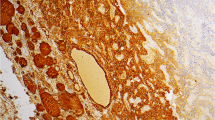Abstract
Background: The FAK gene encodes a 125-kDa tyrosine kinase (p125FAK) involved in signal transduction pathways used in cell adhesion, motility, and anchorage-independent growth. Because thyroid carcinomas have a wide variability in their propensity for invasion and metastasis, we studied the expression of FAK in a variety of thyroid tissues.
Methods: We synthesized a recombinant N-terminal fragment of the human FAK protein and developed a specific polyclonal antisera. Using Western blot analysis, we assessed the levels of p125FAK expression in 30 human thyroid tissue samples from 27 patients that included paired normal and malignant specimens. Levels of FAK protein in individual tumors were quantitated by densitometric scanning of the immunoblots, and the results were correlated with tumor histology and biologic behavior.
Results: The levels of FAK expression were directly correlated with thyroid carcinomas demonstrating the most aggressive phenotypes. The highest levels of p125FAK were seen in follicular carcinomas and tumors associated with distant metastatic foci. In contrast, neoplastic thyroid tissues with limited invasive potential, such as papillary carcinomas, follicular adenomas, and other nonmalignant thyroid lesions, showed minimal p125FAK expression.
Conclusions: Overexpression of FAK may be part of a mechanism for invasion and metastasis of thyroid cancer. Furthermore, the levels of p125FAK may serve as a marker of biologic behavior in this disease.
Similar content being viewed by others
References
Norton JA, Levin B, Jensen RT. Cancer of the endocrine system. In: DeVita VT, Hellman S, Rosenberg SA, eds.Cancer: principles and practice of oncology. 4th ed. Philadelphia: JB Lippincott, 1993:1333–50.
Merino MJ, Boice JD, Ron E, Ain KB, Alexander R, Norton J, Reynolds J. Thyroid cancer: a lethal endocrine neoplasm.Ann Intern Med 1991;115:133–47.
Fusco A, Grieco M, Santoro M, et al. A new oncogene in human thyroid papillary carcinomas and their lymph-nodal metastases.Nature 1987;328:170–2.
Bongarzone I, Pierotti MA, Monzini N, et al. High frequency of activation of tyrosine kinase oncogenes in human papillary thyroid carcinoma.Oncogene 1989;4:1457–62.
Lemoine NR, Mayall ES, Wyllie FS, et al. Activatedras oncogenes in human thyroid cancers.Cancer Res 1988;48:4459–63.
Fagin JA, Matsuo K, Karmakar A, Chen DL, Tang S-H, Koeffler HP. High prevalence of mutations of the p53 gene in poorly differentiated human thyroid carcinomas.J Clin Invest 1993;91:179–84.
Terrier P, Sheng Z-M, Schlumberger M, et al. Structure and expression ofc-myc andc-fos proto-oncogenes in thyroid carcinomas.Br J Cancer 1988;57:43–7.
Mincione G, Cirafici AM, Lazzareschi D, Pepe S, Ciardiello F, Colletta G. Loss of thyrotropin regulation and transforming growth factor B-induced growth arrest inerbB-2 over-expressing rat thyroid cells.Cancer Res 1993;53:5548–53.
Robbins J. Approaches to the treatment of high-risk thyroid cancer.Thyroid 1994;4:385–7.
Schaller MD, Borgman CA, Cobb BS, Vines RR, Reynolds AB. pp125FAK, a structurally distinctive protein-tyrosine kinase associated with focal adhesions.Proc Natl Acad Sci U S A 1992;89:5192–6.
Guan J-L, Shalloway D. Regulation of focal adhesion-associated tyrosine kinase by both cellular adhesion and oncogenic transformation.Nature 1992;358:690–2.
Weiner TM, Liu ET, Craven RJ, Cance WG. Expression of growth factor receptors, the focal adhesion kinase, and other tyrosine kinases in human soft tissue tumors.Ann Surg Oncol 1994;1:18–27.
Kornberg L, Earp HS, Parsons JT, Schaller M, Juliano RL. Cell adhesion or integrin clustering increases phosphorylation of a focal adhesion-associated tyrosine kinase.J Biol Chem 1992;267:23439–42.
Burridge K, Turner CE, Romer LH. Tyrosine phosphorylation of paxillin and pp125FAK accompanies cell adhesion to extracellular matrix: a role in cytoskeletal assembly.J Cell Biol 1992;119:893–903.
Zachary I, Rozengurt E. Focal adhesion kinase (p125FAK): a point of convergence in the action of neuropeptides, integrins and oncogenes.Cell 1992;71:891–4.
Cobb BS, Schaller MD, Tzeng-Horng L, Parsons JT. Stable association of pp60src and pp59fyn with the focal adhesion-associated protein tyrosine kinase, pp125FAK.Mol Cell Biol 1994;14:147–55.
Bergman M, Joukov V, Virtanen I, Alitalo K. Overexpressed Csk tyrosine kinase is localized in focal adhesions, causes reorganization of αvB5 integrin, and interferes with HeLa cell spreading.Mol Cell Biol 1995;15:711–22.
Weiner TM, Liu ET, Craven RJ, Cance WG. Expression of focal adhesion kinase gene and invasive cancer.Lancet 1993;342:1024–5.
Bond JA, Wyllie FS, Rowson J, Radulescu A, Wynford-Thomas D.In vitro reconstruction of tumour initiation in a human epithelium.Oncogene 1994;9:281–90.
Harlow E, Lane DP.Antibodies: A laboratory manual. Cold Spring Harbor, NY: Cold Spring Harbor Laboratory, 1988.
Sambrook J, Fritsch EF, Maniatis T, eds.Molecular cloning—a laboratory manual. 2nd ed. New York: Cold Spring Harbor Press, 1989:18.60–18.75.
Wynford-Thomas D. Molecular basis of epithelial tumorigenesis: the thyroid model.Crit Rev Oncol Hematol 1993;4:1–23.
Liotta LA, Steeg PS, Stetler-Stevenson WG. Cancer metastasis and angiogenesis: an imbalance of positive and negative regulation.Cell 1991;64:327–36.
Mazzaferri EL. Management of a solitary thyroid nodule.N Engl J Med 1993;328:553–9.
Gharib H, Goellner JR, Zinsmeister AR, Grant CS, Van Heerden JA. Fine-needle aspiration biopsy of the thyroid: the problem of suspicious cytologic findings.Ann Intern Med 1984;101:25–8.
Author information
Authors and Affiliations
Rights and permissions
About this article
Cite this article
Owens, L.V., Xu, L., Dent, G.A. et al. Focal adhesion kinase as a marker of invasive potential in differentiated human thyroid cancer. Annals of Surgical Oncology 3, 100–105 (1996). https://doi.org/10.1007/BF02409059
Received:
Accepted:
Issue Date:
DOI: https://doi.org/10.1007/BF02409059




